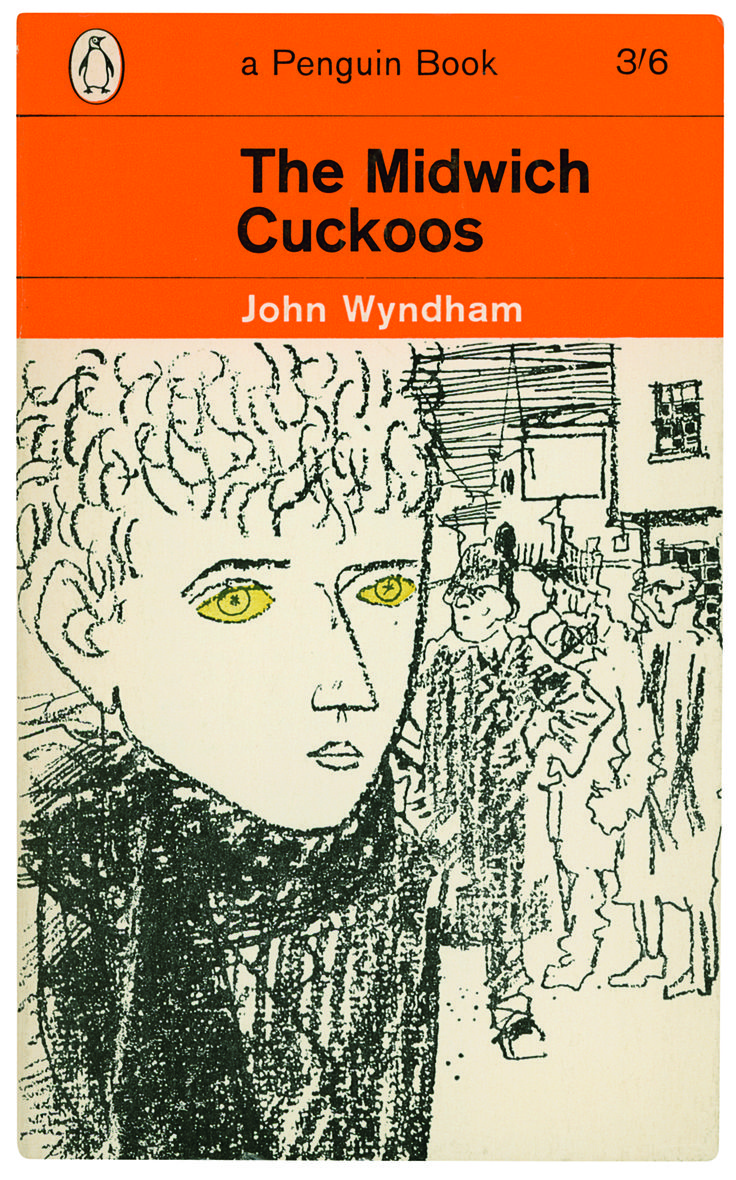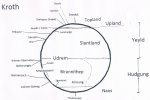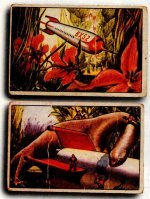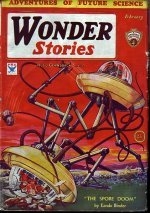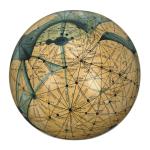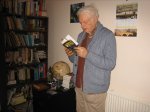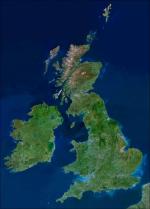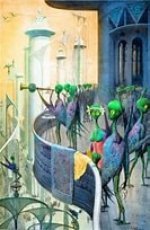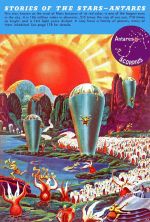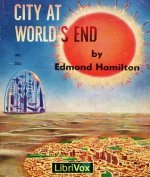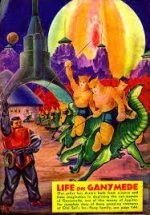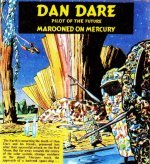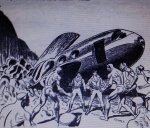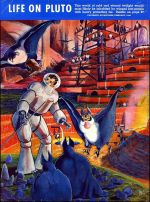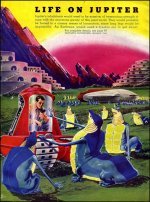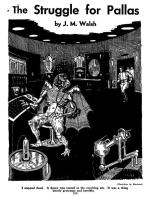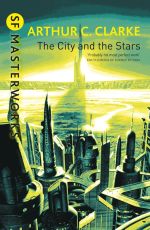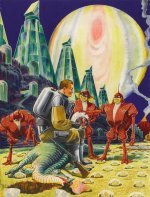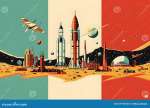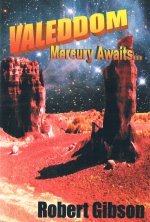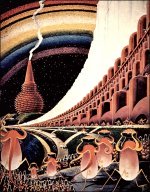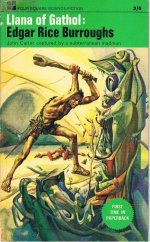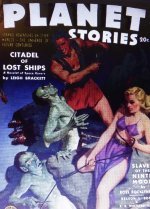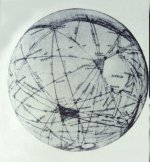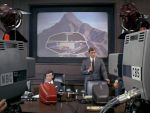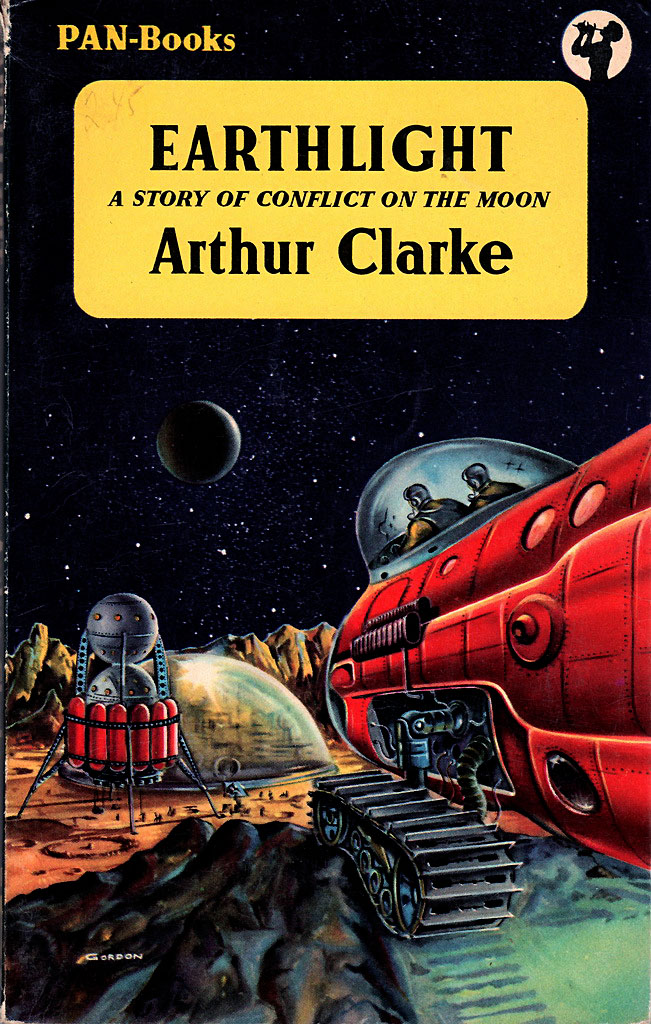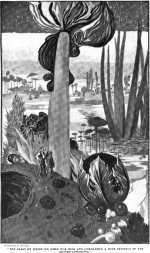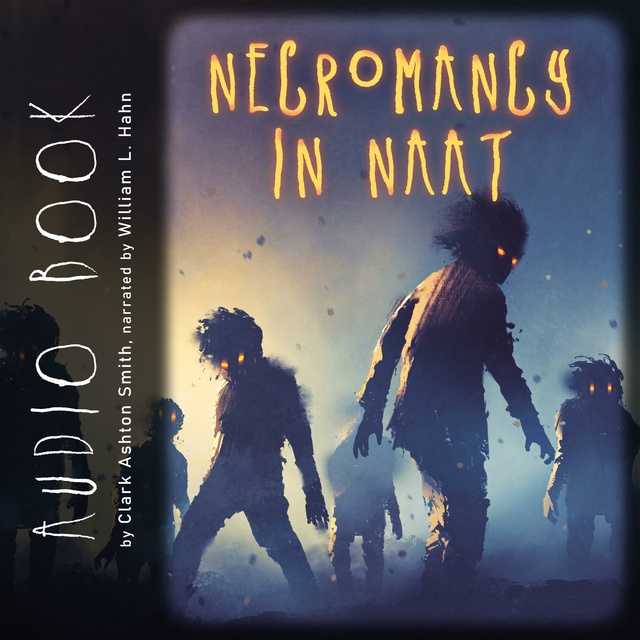a brief history of ooranye
6: the phosphorus era
[continued from 5: The First Sunnoad]
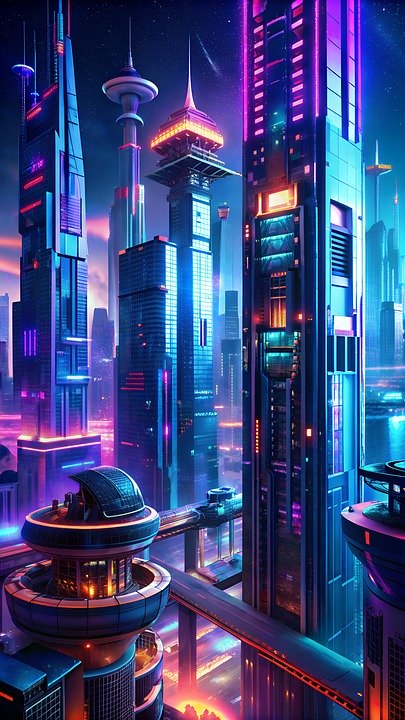
Introduction: the glory of Era 15
The Phosphorus is commonly thought of as the greatest era. It may not be the most spiritual, and other ages may have a subtler aura of romance, but no other period has quite the same classic, purple aura of majestic splendour. The reason for this unique prestige is that the Nenns of the Phosphorus Era had the advantage of surprise in their enjoyment of the sudden “windfall” of power from Chelth, and held that advantage for nearly fifteen million days – fifty thousand Terran years.
To put it metaphorically, all potential rivals, all the non-human and anti-human forces of the giant planet were “caught napping” during this immense period. They took one startled look at the achievement of Man, realized they could not compete – and so decided, during this time, to continue their nap.
Therefore, although humans never can “conquer” Ooranye, in Era 15 they came closest to looking as though they might do so. Some real hope and expectation existed, that Syoom might extend to cover the planet.
In truth the population of Syoom did surge, millions of Syoomeans colonizing borderlands which had never before been settled, expanding the boundaries of civilization – in other words, enlarging Syoom itself. But in addition to this general advance, the sheer lordliness and might of that era spilled deep into Fyaym by means of particular incursions which left outposts that in some cases have survived to this day. And everywhere, from the heartlands to the outposts, the windfall of power brought forth an epic pride, a confidence and reach of spirit which dazzled contemporaries and haunted the planet’s future memories.
First, the great question at the start of the era:
How best to use the power from Chelth?
The stolen treasure lay shimmering in huge “vats” beneath Skyyon on Day One – the immense, unrepeatable, ill-gotten gain, grabbed at the expense of another universe. The deed had been done, and could not be undone. The time had now come to decide how to use it. The people of Syoom, stunned by recent events, were waiting quietly, but their leaders knew that no false move would be forgiven at this historic moment. And the pressure on the decision-makers became all the greater after it was reported, by the scientists monitoring the “vats”, that the contents were evaporating. The rate of loss was slow – close to the limit of detection – but it was enough to wipe out the possibility of conserving a share for future eras to deal with. The decision had to rest with the people of the Phosphorus Era.
When the Noads of the twenty-five greatest cities met in conclave to elect a successor to Sunnoad Hyala Movoun, two main political factions had already emerged.
One faction was strongly in favour of using up the power in the vats fast. These “hotheads” pointed out that, in view of its relatively short half-life, the power was best used at once. All delay must be wasteful. Splurge it now, they advised. Give civilization an explosive boost. Lift the human story thereby onto a new level, with permanent effect. “Then society shall never fall back into the grim chaos of the Nitrogen Era.”
The opposing “coolheads” argued as follows: “This store of energy has been bought with the life and perhaps the soul of Hyala Movoun 1. We dare not use it in any but the wisest way. We must make sure we use it in accordance with the best interests not only of our era but of all Great Cycle time. And since it is not reasonable to expect any single generation to come up with all the best ideas, we ought to leave some of it to our successors – diminished though the store will be; for evaporation is not the only form of wastage. Premature decision-making could prove worse.”
After two days’ debate, and in recognition of the necessity for speed, a seemingly safe, compromise candidate – one who apparently belonged to neither faction – was chosen as the Second Sunnoad.
Lamiroth Eren 2 had been a respected educationalist who had known and worked with Hyala Movoun 1 during the Oxygen Era, before her elevation to the sunnoadex. He soon turned out to be a wise choice. In the next few days he steered the conclave towards a consensus.
“Our plunder,” he said, not mincing words, “according to what our savants tell me, has a half-life of some hundreds of [Uranian] years. This is a small length of time compared with the Great Cycle, so we cannot afford to be complacent. But neither need we be precipitate. Using the arguments which I have heard from you, sponndarou, and from our scientists, engineers, economists and military experts, as Sunnoad I announce the following plan:
“Half of the contents of the power-vats shall be left untouched for the time being, for future generations to use as they see fit. The other half shall be used by ourselves to lift our civilization to a higher level and keep it there.
“Of this half, eighty per cent shall be used to realize the engineer’s dream of indestructible, disc-on-stem foundations of ultimate metal, on which to base the rebuilding of the twenty-five greatest cities of Syoom. This will elevate these cities into a new order of security and power, with the realistic hope that they will endure for the entire length of the current Great Cycle.
“Of the remaining twenty per cent, sixteen per cent shall be used in the compression of frozen energy to create one hundred thousand null-gravity cores for airships, besides billions of cheap buoyancy shards for skimmers.
“The final four per cent shall be used to fabricate tools and industrial plant of varying quality – I say deliberately varied, so that they will not all wear out at the same time. There shall be no repetition of the energy crisis which arose from the depletion of the Sun-Egg. We must bring a higher economy into secure existence.”
This sheaf of decisions acquired the name the Choice of the Way – reflecting the immensity of its importance for all future eras. By and large, historians agree that the choices made were good, perhaps the best possible under the circumstances. We need, however, to note two major unforeseen consequences.
The first concerns the four per cent used for the variety of small objects and installations – tools, machines, plant – that was meant to vitalise the economy. “Vitalise” it did, to an unintended degree. Chelthan energy, to an extent not understood at the time, was purposive. It possessed a strong inherent morphogenetic field which began the long process whereby cities became holistic collections of machines with a vegetal capacity to put forth growths. What strikes Terran visitors nowadays about Uranian city maintenance is the extent to which human workers “tend” rather than “administer”, and this theme can be traced back to the Choice of the Way at the beginning of the Phosphorus Era.
Hence, industrialism has never led to ugliness on Ooranye. There, technology is a branch on the tree of life – an efflorescence of self-developing mechanisms, with city maintenance becoming city cultivation, since opting for the disc-on-stem design meant that all subsequent construction was apt to “fold around” that decision like climbing plants trained onto a trellis. (Thus began the machine evolution that would, eras later, culminate in the Ghepions.)
The second unforeseen consequence of the Choice of the Way arose from the decision to save half the power-store for future use.
This meant that some Chelthan power was not completely consumed until the end of the era. During hundreds of lifetimes, therefore, the stuff was steadily leaking into the atmosphere around Skyyon.
As a result, for thousands of miles around the sunward pole of the planet, a faint nimbus suffused the air. It is now obvious that this radiation affected people’s minds. Admittedly, the “seepage effect” is too glibly invoked by second-rate historians as an explanation for each singular characteristic of Era 15. We can but guess to what extent the “seepage” was responsible for the hubris and nemesis at the end of the era. And to be fair, we must also allow it to have contributed to the greatness that shone before. It elevated people’s thoughts, spured them with extra ambitions, incited deeds which burnish the legends of the Phosphorus Era and made of it a lit stage on which an epic was played out.
The Disc-on-Stem Cities
By far the largest portion of the power plundered from Chelth was used to build the twenty-five virtually indestructible disc-on-stem platforms of iedleis, the ultimate metal. Piled high with branching walkways, globular palaces and helical towers, the platforms comprise the familiar Uranian metropoli of all subsequent eras. Their bases, stems and floors stand today as they stood a million Earth-years ago, and as they will stand for the rest of the Great Cycle of Uranian history. A direct hit by a nuclear bomb would not dent the metal of which the platforms are composed, though the superstructures would be obliterated.
The construction of these cities took an amazingly short time – less than a thousand days – and all of them (except Grard, the last) were built simultaneously at the beginning of the era.
Together with cheaper airships and the re-equipment of the economy, the new city structures gave the Uranians unprecedented riches and power. Note however that this was an enabling boost, an acceleration rather than a deviation of history. Paradoxically, the alien Chelthan power had allowed Ooranye to realize itself; had encouraged indigenous trends to develop more quickly, more fully and more freely.
This can be seen in the case of the city hive-minds. These instances of occasionaly group-consciousness were almost entirely human in composition (with a small contribution from a few administrative computers) and must not be confused with the much later sentient cities of Era 47 onwards. Group consciousness can be seen as a natural development of the renl co-ordinating instinct which evolved during the Lithium Era.
With hindsight, we can see the middle of Era 15 as the “Age of Innocent Hives”. That is to say, in those times, in places where urban group-minds shimmered on the edge of existence they did so by and large without any clash with human freedom. In discussion of Era 15 the term “group mind” usually refers only to a sort of vague Overgovernment existing continuously on a fractional “tax of awareness”, levied unobtrusively on each mind within range. In the very few cases that went wrong (as in the example of Hoog), events provided a dramatic and salutary warning for everyone else. Otherwise, peace and goodwill reigned between city-minds and individual man. In no subsequent age did this smooth equilibrium return for Syoom as a whole (though the greatest, happiest and most successful hive-mind, that of the Aoan Paramountcy, belongs to the much later Xenon Era).
This success story was based, paradoxically, upon ignorance. In the Phosphorus Era most of the people most of the time were unaware that hive-minds existed. On the few occasions that they were fully perceived and admitted, they were regarded with fear and horror; the example of Hoog, the aforementioned hive-mind that went wrong, reinforced the prejudice. Like love, like humour, the Era 15 style of group consciousness depended upon spontaneity and would wither under scrutiny.
Politics in the Phosphorus Era
The sensation of confidence in the mighty achievements of Syoom meant that long stretches of time went by without people feeling the need for any Sunnoad. Even when one was elected, nen’s reign was usually very short – lasting only for the length of the crisis which nen had been called to solve, after which it was a case of Cincinnatus going back to his plough. Meanwhile the Noads of the powerful twenty-five cities had greater resources of power at their command than any rulers have had since. Thus, statistics for the hazard-contours in this period could be compiled the expensive way, by the use of the Great Patrols of airships and of the hemispheric force-fields called dlaxou (which were invented early in the era) rather than from humbler journeys of individual wayfarers on their skimmers. The Great Patrols were an extravagant way of doing it – but they had the good effect, that the mawos, those floating sky-weeds which had caused such bother in the Lithium Era, were so reduced in numbers by the relentless supervision, that they were never again a widespread nuisance.
The Bank of Light
Although power and global ambition were the keynotes of Era 15, other voices were not altogether suppressed. Counter-balancing the increased hubris of the leading Noads was the institution known to its friends and supporters as the Bank of Light.
Ironically enough it grew out of a failed military project. Researchers had been trying to collect and “bottle” aggressive emotions which might then be concentrated and blasted at an enemy as a sort of mind-bomb. The project was abandoned as unfeasible. However, one of the former researchers, who happened also to be trained in techniques of contemplation, did succeed, secretly, in storing a different kind of force – a kind of awareness-force dependent not upon the will but upon the passive appreciation of the world. After many obstacles had been overcome this researcher managed to found the so-called Bank of Light.
This was the nickname of the tongue-twister Rgiohafnarn Dzeld or “Voluntary Contemplation Store”. Its emblem was an L shape signifying the belief that what was important was being, which was in some sense at right angles to the dimension of event and action, and just as entitled as they to the status of “achievement”.
The Bank of Light opened branches in every city. Volunteers donated their time and concentration, to project part of their contemplative force into the great shimmering receptacles in the vaults of the Bank.
This accumulated force was to play a great part in salvaging a large part of civilization from the disasters which befell Syoom at the era’s end.
The Verdict of History
Towards the end, the civilization of the era began to suffer the strains of its own arrogance. The powerful Noads and their peoples conceived a hatred and fear of the community “hive-minds” – sometimes with partial justification, as the hives themselves grew exaggerated and sinister (the reader is referred again to the example of Hoog). Meanwhile, the cultures of the great cities showed signs of eccentricity and instability. Take the case of Vyanth: its agriculturalists bred a strain of vheic – the staple ell-light plant, or “power-plant” – which glowed continuously, instead of in the waxing and waning rhythm natural to Ooranye; this doubled the city’s economic resources, but had the unexpected effect that its people began to stay awake all the time, so that in a few generations sleep was forgotten. Such aberrations were fortunately swept away in the disaster which ended the era.
The next chapter of this history shall relate how the ambitions of the Phosphorus culminated in a hugely ambitious gamble, which in its failure taught humanity a lesson so priceless that subsequent eras have remembered the ill-fated Sunnoad Fiarr Fosn and his doomed followers with persistent gratitude, notwithstanding the cataclysmic close of Era 15 with its huge loss of life and its contraction of Syoom.
Even
by the Uranians of our own day, the 723rd Sunnoad and his captains are
still viewed as heroes. It is pleasant to relate, moreover, that because Nenns commonly
live two or three lives, widely separated in time, and retain memory of their first
life during their second, Fiarr Fosn himself was given the opportunity in a subsequent
era to atone for his mistake.
